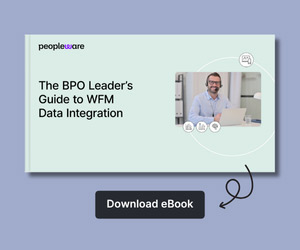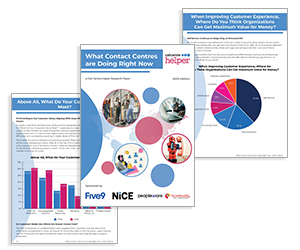Workforce management (WFM) is essential to running an efficient, responsive contact centre. But over time, unhelpful habits can quietly take hold.
These issues often go unnoticed, until performance stalls, teams burn out, or results start to slip.
Many of these problems aren’t caused by tools or systems, but by how WFM is viewed and managed within the business.
To find out more we asked Richard Saqladi, Regional Sales Director at Peopleware (formerly injixo), to explain the bad habits that can kill your WFM strategy and what contact centres can do to fix them.
Video: Habits That Kill WFM Strategy: Stop Leaving WFM in a Silo
Watch the video below to hear Richard outline what contact centres are doing to damage their WFM strategy and the steps they can take to put it right:
With thanks to Richard Saqladi, Regional Sales Director peopleware (formerly injixo), for contributing to this video.
This video was originally published in our article ‘10 Bad Habits That Kill Resource Planning’
Common Bad Habits With WFM Strategies
Bad habits in WFM often go unnoticed, that is until results stall, efficiency drops, or teams start burning out.
So, let’s take a look at a few of the bad habits that impact contact centre WFM:
WFM Treated as a Back-Office Task
One major issue is that WFM is often kept at arm’s length from wider business decisions.
When planners aren’t included in discussions around marketing, recruitment, or product launches, they’re left reacting to events instead of preparing for them, which limits their ability to forecast demand accurately, as Richard explains:
“One of the most common issues we’ve seen in WFM, in the teams, is treating WFM as just a back-office function.
When the WFM system is siloed away, it can’t influence decisions like product launches, marketing campaigns, hiring plans, or any of the big decisions that actually shape demand. So even with great tools in place, the impact just isn’t there.”
Sticking With Outdated Processes
“We’ve always done it this way” is a mindset that stops progress in its tracks, and many teams still rely on legacy processes that no longer serve their purpose.
“There’s the habit of clinging to legacy processes without ever questioning them. We’ve heard it a million times – ‘we’ve always done it this way’.
That sort of mindset is one of the biggest blockers to improvement. The processes that maybe made sense a decade or so ago are highly likely inefficient, and pretty much I can guarantee no longer fit for purpose.”
These outdated methods slow teams down and often don’t reflect the current needs of the business or its customers.
No Succession Planning
When experienced planners leave, they often take critical knowledge with them, as Richard continues:
“Another bad habit we see is neglecting succession planning. If your best planners leave and take their knowledge with them, you’re left scrambling with outdated spreadsheets and makeshift solutions. This makes your team vulnerable and limits their ability to effectively use the WFM system.”
Without documented processes or clear role handovers, the team is left patching together solutions from old spreadsheets or incomplete data, which makes the team vulnerable and inefficient.
Subtle Issues That Build Over Time
Even small inefficiencies can add up, and although these issues may not be obvious at first, over time they impact team morale, efficiency, and customer experience. For example:
- Inaccurate or outdated data leads to poor forecasting
- Rigid shift schedules clash with real-life needs
- Manual absence tracking causes chaos during busy periods
- Training and feedback are inconsistent or completely lacking
“There are more subtle issues like outdated, or incomplete, data for forecasting, rigid schedules that don’t reflect people’s lives, manual absence tracking that creates absolute chaos during peak periods, and little to no investment in training or feedback loops. Each of these habits compromises the effectiveness of your WFM efforts over time.”
Four Ways to Break Bad Habits in Workforce Planning
Improving your WFM approach doesn’t require sweeping reforms, it’s about addressing the habits and assumptions that are holding you back, and according to Richard:
“These changes don’t require a full reset, just small consistent steps in the right direction, and over time I can guarantee they’ll build a culture where WFM isn’t working in the background but is actually helping to move the business forward.”
To get you started, here are four small, focused changes you can use to build a workforce planning function that’s flexible, strategic, and truly effective:
1. Make WFM Part of Strategic Planning
WFM should not be working in isolation, so you need to bring planners into key meetings and give them access to the full picture, such as upcoming campaigns, hiring plans, and changes in customer behaviour.
This helps them move from reactive firefighting to proactive planning, as Richard explains:
“Start by embedding WFM into strategic planning. Don’t treat it like a back-office task, bring it into the conversations that matter. When your planners understand what’s happening across the business, they can prepare, be proactive, and not be simply reacting all the time.”
2. Build a Culture of Continuous Improvement
Question existing processes regularly, and look at what can be automated, or what’s no longer working.
You should also encourage teams to learn from mistakes and look for smarter, more efficient ways of working.
“Build a culture of continuous improvement. Reassess your current processes, look out for where you can automate the repetitive stuff and where you fail, what can you learn from that? Where’s the opportunity?”
3. Prioritize Knowledge Sharing
Avoid knowledge silos by rotating responsibilities, documenting workflows, and creating backup plans.
“Another key thing is to invest in knowledge sharing and development. Create clear documentation, rotate responsibilities, train your team continuously, and upskill them regularly too.”
Regular training and upskilling help the team stay prepared, even when people leave or roles shift.
4. Modernize the Way You Work
Use technology to remove friction. For example, you could:
- Automate time-off management
- Offer flexible scheduling options
- Make key metrics available to all
- Introduce regular feedback loops
These updates help staff feel supported and allow WFM to work with, not against, the realities of a modern contact centre.
“Modernize outdated practices. Make metrics available, use flexible scheduling where you can, automate time-off management, and make feedback part of your everyday operations, not a once a year formality.”
If you are looking for more great insights from the experts, check out these next:
- Tips to Improve Call Abandonment Rates
- The Hidden Cost of Poor Scheduling
- Reducing Abandoned Calls by Understanding Why
- How to Stay Ahead of Digital Customer Demand
Author: Robyn Coppell
Reviewed by: Xander Freeman
Published On: 3rd Oct 2025 - Last modified: 9th Oct 2025
Read more about - Video, Peopleware, Richard Saqladi, Videos, Workforce Management (WFM)






































